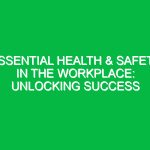Introduction
In today’s fast-paced work Environment, the significance of health and Safety in the workplace cannot be overstated. Health and Safety and work, particularly within the realm of Health, Safety, and Environment (HSE), play a crucial role in preserving the well-being of employees and the Sustainability of organizations. These practices are designed not only to protect workers from physical harm but also to foster a culture of safety that permeates the entire organizational framework.
Imagine walking into an office where every surface is clean, every piece of equipment is maintained, and employees are aware of their surroundings. This is not merely an idealistic vision; it is a tangible outcome of effective health and safety practices. In this article, we will explore essential health and safety practices, delve into the significance of HSE Standards, and provide actionable insights for establishing a safer workplace.
Understanding Health and Safety in the HSE Context
Health and safety and work encompass a broad range of practices aimed at preventing accidents, injuries, and illnesses in the workplace. This involves identifying potential Hazards, assessing risks, and implementing measures to mitigate those risks. The HSE framework serves as a guiding principle for organizations to create safe working environments, ensuring that employees can perform their duties without fear of harm.
Several components are integral to effective health and safety practices, including risk assessment, training, emergency preparedness, and ongoing monitoring. Each of these elements contributes to a holistic approach that prioritizes employee well-being and compliance with legal Regulations.
Key Aspects of Health and Safety Practices
1. Risk Assessment
One of the foundational pillars of health and safety and work is risk assessment. This process involves identifying potential Hazards that could cause harm to employees. Hazards can be physical, chemical, ergonomic, or biological. For instance, in a manufacturing facility, heavy machinery poses a physical risk, while exposure to chemicals can lead to health issues.
Conducting a thorough risk assessment requires collaboration among various stakeholders, including management, employees, and health and safety professionals. To illustrate, consider a scenario where a warehouse is found to have improperly stacked boxes. During a risk assessment, this hazard is identified, and corrective actions, such as rearranging the boxes and Training employees on safe stacking techniques, are implemented.
2. Training and Awareness
Training is another critical aspect of health and safety and work. Employees must be equipped with the knowledge and skills necessary to recognize hazards and respond appropriately. This includes training on the proper use of Personal Protective Equipment (PPE), emergency Procedures, and safe handling of materials.
For example, in a construction setting, workers must be trained in Fall Protection techniques. A construction company that prioritizes training can significantly reduce the likelihood of falls, protecting both employees and the organization from potential legal ramifications. Regular refresher courses ensure that employees remain aware of the latest safety protocols.
3. Emergency Preparedness
No workplace is immune to emergencies, whether they be natural disasters, medical emergencies, or workplace accidents. Effective emergency preparedness involves creating and communicating an emergency response plan that outlines protocols for various scenarios. This plan should include evacuation routes, designated assembly points, and instructions for reporting incidents.
A real-life example can be seen in the case of a chemical spill in a laboratory setting. Having a well-defined response plan in place allows employees to act swiftly, minimizing harm and facilitating a prompt cleanup. Regular drills can help reinforce these protocols, ensuring that employees are familiar with emergency procedures.
4. Monitoring and Continuous Improvement
Health and safety practices should not be static; they require continuous monitoring and improvement. Organizations need to establish mechanisms for reporting incidents and near-misses, analyzing trends, and implementing changes based on findings. This iterative process fosters a culture of safety where employees feel empowered to speak up about potential risks.
Consider a scenario where an organization experiences a spike in reported near-misses related to equipment malfunctions. By investigating these incidents, management can identify underlying issues, such as inadequate Maintenance schedules, and take corrective measures. This proactive approach not only enhances safety but also builds trust among employees.
Identifying Hazards and Risks
Understanding the different types of hazards that may exist in a workplace is crucial for effective health and safety management. Broadly, hazards can be classified into several categories:
- Physical Hazards: These include things like machinery, noise, and temperature extremes that can cause harm.
- Chemical Hazards: Exposure to harmful substances, such as solvents, asbestos, or cleaning agents, falls into this category.
- Ergonomic Hazards: Poor workstation design or repetitive motion can lead to musculoskeletal disorders.
- Biological Hazards: These include exposure to bacteria, viruses, or other harmful biological agents, especially relevant in healthcare settings.
Recognizing these hazards is the first step in mitigating risks. For instance, in an office environment, ergonomic assessments may reveal that employees are at risk of developing repetitive strain injuries due to improper desk setups. Implementing ergonomic solutions, such as adjustable chairs and standing desks, can significantly reduce these risks.
Regulations and Standards Governing Health and Safety
Compliance with health and safety regulations is not optional; it is a legal requirement in many jurisdictions. Various regulations, such as the Occupational Safety and Health Administration (OSHA) standards in the United States or the Health and Safety at Work Act in the UK, set forth guidelines for maintaining safe workplaces.
These regulations often mandate specific practices, such as conducting regular safety audits, maintaining records of incidents, and providing employees with appropriate training. Failure to comply with these regulations can result in severe penalties, including fines and legal action, as well as damage to an organization’s reputation.
Organizations should familiarize themselves with relevant regulations to ensure compliance. For instance, a manufacturing facility must adhere to osha standards regarding machine safety. By understanding and implementing these regulations, organizations can minimize risks and enhance their overall safety culture.
Benefits of Implementing Health and Safety Practices
The advantages of prioritizing health and safety and work extend beyond compliance; they encompass numerous Benefits that positively impact the entire organization. Some key benefits include:
- Reduced Workplace Injuries: Effective health and safety practices lead to fewer accidents, resulting in a healthier workforce.
- Increased Productivity: Employees who feel safe and supported are more engaged and productive, contributing to organizational success.
- Enhanced Reputation: Organizations committed to health and safety earn the trust of clients, stakeholders, and the community.
- Cost Savings: Fewer accidents lead to lower insurance premiums, reduced medical costs, and decreased absenteeism.
A notable example can be seen in companies that have implemented comprehensive health and safety programs. For instance, a large construction firm reported a 40% decrease in workplace injuries after launching a robust safety training initiative. This not only saved costs associated with worker compensation but also improved overall morale among employees.
Actionable Guidelines for Establishing a Safer Workplace
Organizations looking to enhance their health and safety practices can take several actionable steps:
- Conduct Regular Risk Assessments: Schedule regular assessments to identify new and existing hazards.
- Invest in Training: Provide ongoing training for employees at all levels to ensure everyone is equipped to handle potential risks.
- Foster Open Communication: Encourage employees to report hazards and near-misses without fear of reprisal.
- Implement Safety Policies: Develop clear safety policies and procedures that are easily accessible to all employees.
- Monitor and Review: Regularly review and update safety practices based on feedback and incident reports.
By following these guidelines, organizations can create a proactive safety culture that minimizes risks and promotes employee well-being.
Conclusion
In conclusion, the importance of health and safety and work within the HSE context cannot be underestimated. Organizations that prioritize health and safety practices not only protect their employees but also enhance their operational efficiency and reputation. By implementing effective risk assessment protocols, training programs, and emergency preparedness plans, organizations can cultivate a safer workplace environment.
As we have explored throughout this article, the journey toward establishing a culture of safety is ongoing. It requires commitment, vigilance, and a willingness to adapt to changing circumstances. In the ever-evolving landscape of work, investing in health and safety is not merely a regulatory obligation; it is a moral imperative that shapes the future of workplaces everywhere.
Encouraging a proactive approach to health and safety is essential for fostering an environment where employees can thrive. By making safety a shared responsibility, organizations can pave the way for a healthier, safer, and more productive workplace.


